|
| |
[View / Print / Save this letter as a PDF file.] [Download
Adobe Reader PDF file reader.]
7 July 2005 Click
on the pictures to enlarge them.
Greetings again from New Mexico.
In the first half of this year we accomplished our great Australian adventure
that had been in planning since last year's trip to Ireland. That adventure was
in March and April. This past winter was one of great snowfall. In January we
drove up to Sandia Crest which overlooks Albuquerque from nearly 11,000 feet
altitude. There was a lot of snow up there. All the mountains out here received
a great amount of snow. We saw much on our April trip to Utah. Now that much of
the snow has melted, our lakes and reservoirs are filling. This is welcome
relief as we have had several years of drought. In February, we made a one-day
visit to the Bosque Del Apache wildlife preserve. After returning from
Australia, we spent 11 days on a visit to Utah. In June we took a 3-day vacation
to Navajo Lake in northwest New Mexico. From January to June, Robert worked on a
complete revision to our web site.
BOSQUE VISIT
This year we once again joined friends of ours from church for a bus trip to the
Bosque Del Apache near Socorro, New Mexico.
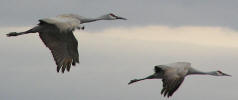 Sandhill Cranes fly in at sunset.
Sandhill Cranes fly in at sunset.
AUSTRALIAN ADVENTURE
We left on our Australian adventure on 10 March and returned on 8 April. We
visited many distant Malseed family members, and we covered a lot of territory.
The trees, birds, and other animals are very different. We saw some very dark
skies (especially in the outback) with the southern stars. The constellation
Orion is upside down and the sun and moon travel through the north during the
day. And, of course, Aussies drive on the left side of the road. We stayed with
John & Helen Malseed when we arrived in Sydney on 12 March. They live north of
Sydney in Terrigal.
(Click the hyperlinks in the text below for more
information about places we visited.)
 The Opera House - symbol of Sydney.
The Opera House - symbol of Sydney.
We saw that area and Sydney for a couple days, and then we headed south in their
car to Canberra, the capital. We viewed the city from Telstra tower on Black
Mountain Lookout, looked at the embassies, spent several hours at the
War Memorial (museum), and spent time in
Parliament.
 Canberra Panorama from Telstra Tower.
Canberra Panorama from Telstra Tower.
We sat in the House of Representatives during question time when the Prime
Minister, John Howard, and cabinet ministers answer questions from each side of
the aisle. The rowdiness of the representatives was a bit of a surprise to us.
Late in the afternoon we continued riding south to the Princes highway and
stayed overnight at Bellbird. At dusk that evening we saw our first mob of
kangaroos. In the morning we continued down the highway through Lakes Entrance
and on to John’s cousin’s farm east of Melbourne.
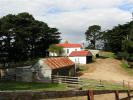 The Farm “Donegal”.
The Farm “Donegal”.
We stayed there a night and then went to his cousin’s home closer to Melbourne
for 2 nights. We went to the Franklin Graham festival in the Telstra Dome one
evening and saw some of Melbourne. The following day we went into the forests
and hills in the Dandenong Ranges.
 Linda with one of the beautiful birds.
Linda with one of the beautiful birds.
On Sunday we met up with Jim Maultsaid
who was visiting from Northern Ireland. Then John & Helen headed back home while
we traveled on with Jim to Portland via the
Great Ocean Road. We stopped to see
the sea stack formations known as the 12 Apostles. (As we write this, the second
stack in this photo [arrow] was destroyed by the sea on 3 July.)
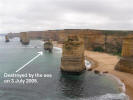 Some of the 12 Apostles.
Some of the 12 Apostles.
When we arrived in Portland, we were met by Leigh Malseed. The next day we went
to his home and he took us to Noel Johnstone’s property where we could see
Malseed Lake which is in the Discovery Bay Coastal Park.
 Malseed Lake just above Robert, Leigh, and Jim.
Malseed Lake just above Robert, Leigh, and Jim.

A close-up of Malseed Lake in Discovery Bay Coastal Park, Victoria, Australia.
We went further up the coast to Mt Gambier where we saw Blue Lake and Malseed
Park (a sports stadium).
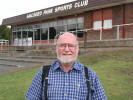 Robert at Malseed Park.
Robert at Malseed Park.
We met Athol Malseed and some of his family for lunch and then went to see the
Malseed Realty office before heading
back to Portland. We saw a flock of Emus on the way and then stopped at
Drik Drik
cemetery to see the Malseed graves there. That evening we met 55 others at
Otway Manor in Portland for a little reunion. Robert gave a slide presentation
about our family and also gave the presentation he had produced for the reunion
in Ireland last June. We met several people we had only known through e-mail. It
was amazing to see 60 Malseed entries in the Portland phone book. More than
anywhere else.
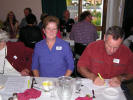 Leigh and Karen Malseed arranged the meeting.
Leigh and Karen Malseed arranged the meeting.
 Robert with Robert William (Bill) Malseed.
Robert with Robert William (Bill) Malseed.
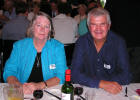 Robert & Estelle Malseed.
Robert & Estelle Malseed.
The next day, Leigh took us on a guided tour around Portland and Cape
Bridgewater including the
cemetery
there where many Malseeds are buried.
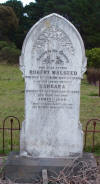 Robert Malseed grave.
Robert Malseed grave.
We stopped at Bridgewater Bay, Bridgewater Lakes, Tarragal Caves, the old
Methodist church, and the Petrified Forest.
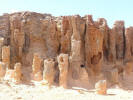 The Petrified Forest.
The Petrified Forest.
We saw a koala that lives in the woods near Leigh’s home. We also stopped to see
Malseed Street in Portland.
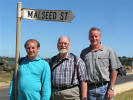 Jim, Robert, & Leigh at Malseed Street in Portland.
Jim, Robert, & Leigh at Malseed Street in Portland.
We also met Brendon Jarrett at Leigh’s home. Brendon is the owner of Henry’s
letters. These are a series of 14 letters written to Henry Malseed, one of the
original settlers from Ireland. They are dated from 1863 to 1885 and offer an
interesting insight into life in Ireland, and the relationships between Malseed
family members who immigrated to Australia and the USA. Robert photographed all
the letters. (In the future, transcriptions of the letters will be posted on the
Malseed web site.) The next day we headed back to Melbourne with Jim. We stopped
at the Condah /
Myamyn Cemetery where many Malseeds are buried and we stopped at Ballarat to
see the gold fields living history museum at
Sovereign Hill.
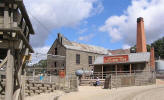 Sovereign Hill Gold Mine.
Sovereign Hill Gold Mine.
In Melbourne (Hawthorn) we stayed with Robert Barrie and Estelle Malseed. The
next day we went to the Melbourne
Museum where we saw a special exhibit of dinosaurs from China, and then got
Jim to the airport to fly back to Belfast. The next day over lunch we met Pat
Miller, whose brother is a member of our church in Albuquerque, and then in the
afternoon we went with Estelle to the Malseed cabin on Phillip Island. On the
Island we went to the Koala Conservation Center.
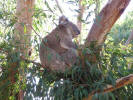 One of many Koalas.
One of many Koalas.
After sunset we went to the
penguin parade.
(Small fairy penguins, only a foot
tall, nest on the island every night.) Many nests were around the cabin and we
could hear the penguins throughout the night. At times they get quite loud.
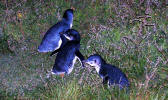 Fairy Penguins.
Fairy Penguins.
The next day we got up early and walked down the gravel road to see the
kangaroos that live there. We saw several of them. Then we went with Robert out
to the family fish farm in the
Dandenong Ranges east of Melbourne. They raise trout and salmon, and people can
come and fish there.
 Pond at the fish farm.
Pond at the fish farm.
They also have a couple kangaroos on the farm. The gum trees on the farm host
many Bellbirds that chimed at us and Kookaburras that laughed at us. Robert then
took us to Emerald where we caught the
Puffing Billy steam train to Belgrave where we transferred to the Melbourne
train system which we rode for 2 hours to Patrick Joseph Malseed’s home in
Carrum Downs. Patrick is a recent immigrant from England.
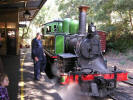 Puffing Billy at the Belgrave station.
Puffing Billy at the Belgrave station.
After visiting with them, we met up with Robert & Estelle back at their home in
Hawthorn.
The next day we flew to Hobart, Tasmania, where Ian and Charlie McLeod met us at
the airport and then took us on a 3-day tour around Tasmania. We spent a night
at Port Arthur where we saw the old
prison. (Tasmania was originally a colony for prisoners.)
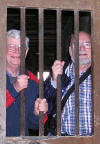 Ian and Robert in Port Arthur prison.
Ian and Robert in Port Arthur prison.
Linda and Charlie allowed Robert & Ian to escape from the prison. The next day
we visited the Dog Line, the Tessellated Pavement, Coles Bay, beaches, and
Freycinet National Park
as we headed north to Ross.
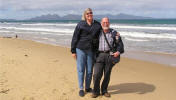 On Nine-Mile Beach.
On Nine-Mile Beach.
The next day we rode south to New Norfolk stopping at
Bonorong Wildlife Park where
we saw several Tasmanian Devils and hand-fed kangaroos and wallabies and petted
a koala. We learned that koalas can be quite noisy.
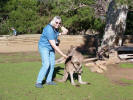 Linda feeds a Roo.
Linda feeds a Roo.
We saw Russell Falls in
Mt Field
National Park, and the lakes and mountains in
Southwest
National Park.
 Linda, Robert, Ian, Charlie at Russell Falls.
Linda, Robert, Ian, Charlie at Russell Falls.
The next day we went atop Mt. Wellington for a panoramic view of Hobart and then
looked at sights in Hobart for a while before heading to the airport.
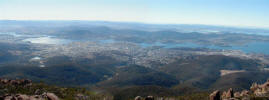 Hobart from Mt. Wellington.
Hobart from Mt. Wellington.
We flew to Melbourne, spent the night at an airport motel, and flew to
Ayers Rock Resort the next day.
Tasmania was cool, but Ayers Rock was hot and dry and in the center of Australia
in the outback. (More like home.) That evening we went to the observatory for a
program on the southern sky. It was a perfect, clear, dark night. We could see
the Southern Cross any night on our trip, but in the outback we could easily see
the Large and Small Magellanic Clouds. The Coalsack could easily be seen as the
head of a large Emu in the night sky. The next morning we took a helicopter tour
of Ayers Rock (Aboriginal name Uluru) and the Olgas (Aboriginal name Kata Tjuta)
which lie west of Uluru. It was surprising to see so many trees out there. Most
are ones called “desert oak”, but they have what looks like pine needles. They
are able to tap into the aquifer that lies under the very dry outback.
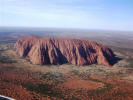 Ayers Rock (Uluru) from our helicopter.
Ayers Rock (Uluru) from our helicopter.
In the afternoon we went on a 4-wheel-drive tour to Mt Conner, a mesa about 60
miles east of Uluru.
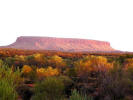 Mt. Conner at sunset.
Mt. Conner at sunset.
That trip was 7 hours and was really interesting. We did see several kangaroos.
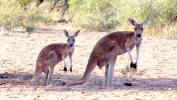 Two of many kangaroos.
Two of many kangaroos.
We saw camel tracks, but no camels. In the evening we had steak at
Curtin Springs Station under the
Bough Shed. “Station” is Australian for “ranch”.
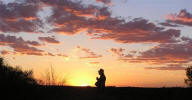 Robert at sunset in the Outback.
Robert at sunset in the Outback.
Curtin Springs cattle station is over 1 million acres. The next morning we were
up early for a sunrise tour of Uluru. Ayers Rock is red sandstone that glows
especially red at sunrise and sunset.
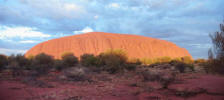 Sunrise at Ayers Rock.
Sunrise at Ayers Rock.
After sunrise we went on a tour guided by an aborigine who explained much about
his culture and how they live in the bush. He spoke through an interpreter.
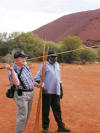 Robert gets spear-throwing lesson.
Robert gets spear-throwing lesson.
After lunch back at the resort we were off on a bus tour to Kata Tjuta (the
Olgas). Whereas Uluru is a single rock, the Olgas are several huge rocks close
together.
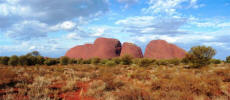 The Olgas (Kata Tjuta).
The Olgas (Kata Tjuta).
We hiked up into Walpa Gorge between two of the rocks. Then we went back to
Uluru for sunset. It was quite cloudy, but the sun shone through the break under
the clouds just before setting and turned Ayers Rock from a dull grey color to a
glowing orange-red.
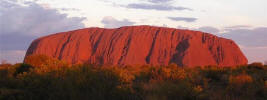 Sunset at Ayers Rock.
Sunset at Ayers Rock.
The next day we flew to Cairns and drove north to Port Douglas on the tropical
Queensland coast. The next morning we went by boat out to the
Great Barrier
Reef which lies off the Queensland coast. We viewed the coral and fish from
the platform which is anchored there and from a glass bottom boat. Then we put
on a lycra suit, mask, fins, and snorkel and spent an hour swimming out over the
beautiful undersea scenery.
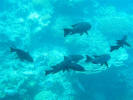 Our view of the Great Barrier Reef.
Our view of the Great Barrier Reef.
The next morning we drove north and crossed the Daintree River by ferry
(noticing the crocodile warning sign) to go to the
Daintree Tropical Rainforest.
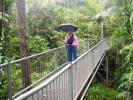 A brief shower in the Daintree Rainforest.
A brief shower in the Daintree Rainforest.
It was hot and humid and there was a brief rain shower. (Some areas of the
forest have 360 inches of rain per year.) It was fascinating. When we returned
to Port Douglas, we visited the
Rainforest Habitat Wildlife Sanctuary to see the animals that are too
elusive to see in the wild.
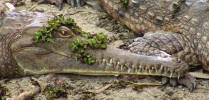 Crikey! Crocs, Mate!.
Crikey! Crocs, Mate!.
Each evening after sunset in Port Douglas we observed dozens of flying foxes
pass overhead. These are large bats whose wingspan can be up to 5 feet. After
three nights there, we flew back to Sydney and spent the last two nights with
John & Helen Malseed before flying back home on 8 April.
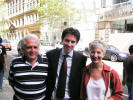 John and Helen with son, Michael.
John and Helen with son, Michael.
UTAH
For some years we had been planning to tour Nine-mile Canyon in Utah. On 19
April we drove the motor home up to Moab, UT, and we spent a day exploring some
areas of Canyonlands that we had never before visited. Then we drove up to
Price. That afternoon we visited the Museum of the San Rafael Swell in Castle
Dale. The Swell is the geologic name of this region of Utah. It includes Emery
county and Carbon county where coal is mined. The famous Cleveland-Lloyd
dinosaur quarry is in the area. The dinosaur bones from this quarry are
blackened by the carbon. We had visited the quarry several years ago. This year
we spent an entire day exploring Nine-Mile canyon that is northeast of Price.
Nine-mile creek flows eastward into the Green River. The Canyon that it cut was
home to many Native Americans and contains evidence of their presence. The
canyon is known for its thousands of sites of petroglyph and pictograph
displays. We saw several dozen sites on our day-long drive up and down the
canyon. Here are some of the best examples of this art work.
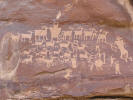 A Petroglyph panel in Nine-Mile Canyon.
A Petroglyph panel in Nine-Mile Canyon.
From Price, we drove up to Salt Lake City where we continued our family history
research. Robert photographed many more Irish property records. He also
discovered more about his Shubert ancestors. We then returned home on 29 April.
WHAT DID YOU SAY?
During our time in Tasmania, Robert caught a cold just before we flew back
to Melbourne. He has always had problems with his Eustachian tubes. He got fluid
in his middle ears. Such fluid usually drains for him in a few days, but this
time it did not. His hearing has been adversely affected and he was given a
variety of medications. Finally, on 6 July his eardrums were cut open, the fluid
sucked out, and rubber tubes implanted. He immediately began hearing clearly.
NAVAJO LAKE
We went to Navajo Lake on 26-29 June. Linda's brother, Jim Baxter, also went
along with Norma Jean and Chris. They took their boat and jet ski so we did some
boating. Here is Chris flying across our wake on his wake board.
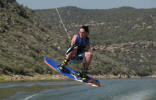 Chris flies on his wake board.
Chris flies on his wake board.
The trip also helped us test the towing equipment we had installed on our new
car. We wanted to tow it behind our motor home. We also put a bicycle carrier on
the hitch on the back of the car. Everything seemed to work well. This is
important because in July-September we plan a 7700-mile motor home trip to the
upper midwest, Canada, and the northwest.
WEB SITE
On 1 June, We published a completely revised web site. Actually it is 2 web
sites. malseed.com is a site for the worldwide Malseed family, while
robert.malseed.com contains the information about our family. Please visit us
there. Our old website is still available at malseed.tripod.com.
SAMANTHA
Samantha, the dog we inherited from Linda’s mother 4 years ago, died when we
went to Australia. She was about 15 years old. It is rather quiet around the
house now. Pico died 2 years ago.
THE BOTTOM LINE
We continue to be thankful for the Lord’s provision for us. We trust in Him,
and pray that you will do likewise and enjoy a wonderful summer of 2005.
Love,
Robert & Linda
Return to top of page.
Page last updated:
09 July 2007
|
